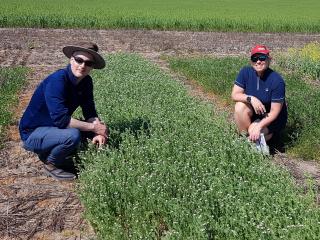Western Australia
March 4, 2020

Department of Primary Industries and Regional Development research scientists Daniel Hüberli and Sarah Collins look over a serradella break crop plot their Calingiri trial.
Western Australian research has provided new insight into break crop options for grain growers facing two major unwanted soilborne pests and diseases in their paddocks.
Soilborne pests and diseases often occur together in Western Australian broadacre paddocks.
Department of Primary Industries and Regional Development scientists have examined break crop options to mitigate the impacts of both root lesion nematode Pratylenchus quasitereoides (RLN) and Rhizoctonia solani AG8 (Rhizoctonia bare patch).
The two-year rotation trials, at Grass Valley and Calingiri found certain pulses, fallow, and some pastures are the best break crop options where both problems occur.
Detailed findings were delivered at last week’s 2020 Grains Research and Development Corporation (GRDC) Grains Research Updates, Perth.
Department research scientist Daniel Hüberli said management techniques for each pest or disease differed, so minimising crop losses when facing a combination of both could be difficult.
“This series of trials is the first time we have examined break crop options to address both challenges occurring concurrently in one paddock,” Dr Hüberli said.
R. solani is a fungal pathogen that causes root rot in a number of crops and can cause losses of up to 50 per cent in wheat.
RLN can also cause significant yield losses, estimated to cost WA wheat growers up to $90 million annually.
Department research scientist Sarah Collins said it was important to understand which soilborne pests and diseases were present before making decisions on the best rotation to reduce yield loss.
Field trials in 2018 and 2019 involved a first-year break crop phase at Calingiri and second-year cereal phase at Grass Valley, which followed different break crops. The trials were supported with funds from GRDC and the department.
“In general, RLN levels were lower under fallow and pastures, and highest under cereals and canola,” Dr Collins said.
“Rhizoctonia bare patch levels were lowest under canola, some pastures and fallow, compared to cereals in the initial break-crop phase and in the cereal phase.
“Optimum wheat yields were achieved in rotations sown after subclover, serradella, lupin or a weed free fallow when levels of RLN and R. solani were also low.
“In the 2020 season, wheat will be sown across the trial at Calingiri to confirm this result.
“These results demonstrate that some pasture, pulse and fallow rotations provide a suitable break when RLN and rhizoctonia bare patch occur in the same paddock.”